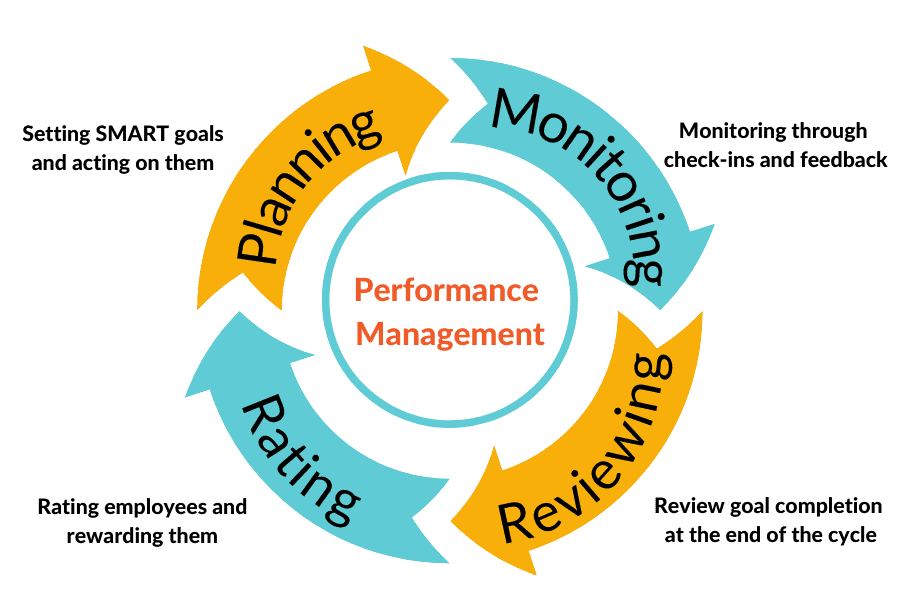Fast-growing companies are continuously seeking new ways to improve performance management, drive business growth, and achieve organizational success. At the heart of this pursuit lies a well-defined and implemented performance management cycle. This cyclical process serves as a framework for evaluating, developing, and motivating employees, ensuring that individual contributions align with organizational goals.
The Four Stages of the Performance Management Cycle
There are four distinct elements to the performance management cycle and they unfold in particular stages, each with its unique objectives and contributions to employee growth and organizational success.
1. Planning: Setting the Foundation for Success
The planning stage marks the initiation of the performance management cycle. During this phase, managers and employees collaborate to set SMART (Specific, Measurable, Achievable, Relevant, and Time-bound) goals that align with individual aspirations and the company’s strategic objectives. These goals serve as the roadmap for the performance cycle, providing direction and focus for employee efforts.
2. Monitoring and Coaching: Ongoing Feedback and Support
The monitoring and coaching stage brings the performance cycle to life. Regular check-ins between managers and employees ensure that progress towards goals is tracked and addressed promptly. This ongoing feedback process promotes continuous improvement and helps employees navigate challenges or roadblocks effectively. Having an executive that has achieved formal performance management certification deliver this stage is a huge advantage for any organization.
3. Reviewing and Evaluating: Assessing Performance and Growth
The reviewing and evaluating stage marks a formal assessment of employee performance against established goals. This stage involves a comprehensive review of performance data, including qualitative feedback from managers, peers, and clients. The evaluation process provides a holistic perspective on employee contributions and identifies areas for further development.
4. Rewarding and Recognizing: Recognizing Achievements and Inspiring Growth
The rewarding and recognizing stage concludes the performance management cycle, acknowledging employee achievements and motivating continuous improvement. Managers may use performance-based rewards, such as bonuses, promotions, or recognition programs, to incentivize and celebrate employee success.
Key Elements of Effective Performance Management
A successful performance management cycle hinges on key elements that ensure its effectiveness and impact on employee growth and organizational success.
1. Clear Goals and Expectations:
Goals should be specific, measurable, achievable, relevant, and time-bound (SMART) to provide clarity and direction for employees.
2. Regular Feedback:
Regular feedback, both formal and informal, is essential for providing employees with timely insights into their performance and areas for improvement.
3. Coaching and Support:
Managers play a crucial role in coaching and supporting employees to achieve their goals and overcome challenges.
4. Open Communication:
Open and honest communication between managers and employees fosters a collaborative environment where concerns can be addressed and feedback is embraced.
5. Data-Driven Decision-Making:
The performance management cycle should utilize data to inform decision-making, identify trends, and measure the effectiveness of interventions.
6. Continuous Improvement:
The performance management cycle should be an ongoing process of continuous improvement, adapting to changing business needs and employee development.
The Impact of a Comprehensive Performance Management Cycle
Implementing a comprehensive performance management cycle yields significant benefits for organizations and employees alike.
For Organizations:
- Enhanced employee engagement and motivation
- Improved productivity and efficiency
- Reduced turnover and increased talent retention
- Data-driven decision-making for strategic planning
- Alignment of individual performance with organizational goals
For Employees:
- Clear understanding of expectations and goals
- Regular feedback and development opportunities
- Increased visibility of contributions and achievements
- Recognition and appreciation for their work
- Growth and development opportunities for career advancement
A well-structured and implemented performance management cycle serves as a cornerstone of organizational success, driving employee performance, enhancing organizational agility, and fostering a culture of continuous improvement. By investing in a comprehensive performance management system, organizations can empower their employees to reach their full potential, achieving remarkable business outcomes and thriving in the competitive landscape.
⚠ Article Disclaimer
The above article is sponsored content any opinions expressed in this article are those of the author and not necessarily reflect the views of CTN News









